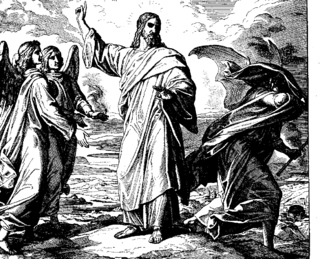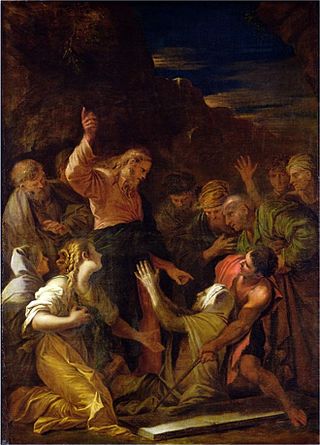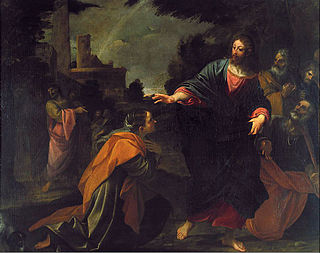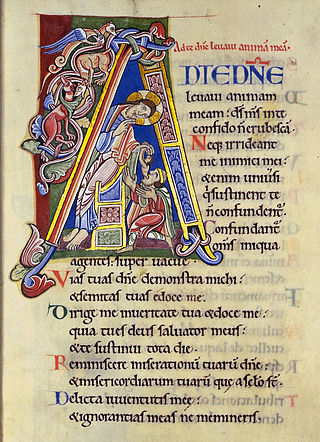The Hittites, also spelled Hethites, were a group of people mentioned in the Hebrew Bible. Under the names בני-חת and חתי they are described several times as living in or near Canaan between the time of Abraham and the time of Ezra after the return of the Jews from the Babylonian exile. Their ancestor was Heth.

Matthew 4:10 is the tenth verse of the fourth chapter of the Gospel of Matthew in the New Testament. Jesus has rebuffed two earlier temptations by Satan. The devil has thus transported Jesus to the top of a great mountain and offered him control of the world to Jesus if he agrees to worship him. In this verse, Jesus rejects this temptation.

Jesus walking on the water, or on the sea, is recorded as one of the miracles of Jesus recounted in the New Testament. There are accounts of this event in three Gospels—Matthew, Mark, and John—but it is not included in the Gospel of Luke. This story, following the miracle of the feeding of the five thousand, tells how Jesus sent the disciples by ship back to the "other side" of the Sea of Galilee while he remained behind, alone, to pray. Night fell and the sea arose as the ship became caught in a wind storm. After rowing against the wind for most of the night, the disciples saw Jesus walking on the water. They were frightened, thinking that they were seeing a spirit, but when Jesus told them not to be afraid, they were reassured. After Jesus entered the ship, the wind ceased, and they arrived at land.

Matthew 7:21 is the twenty-first verse of the seventh chapter of the Gospel of Matthew in the New Testament and is part of the Sermon on the Mount. This verse continues Jesus' warning against false prophets.

Matthew 8:2 is the second verse of the eighth chapter of the Gospel of Matthew in the New Testament. This verse begins the miracle story of Jesus cleansing a leper, the first of a series of miracles in Matthew.

Matthew 8:4 is the fourth verse of the eighth chapter of the Gospel of Matthew in the New Testament. This verse concludes the miracle story of Jesus cleansing a leper, the first of a series of miracles in Matthew.

Matthew 8:10 is the tenth verse of the eighth chapter of the Gospel of Matthew in the New Testament. This verse continues the miracle story of healing the centurion's servant, the second of a series of miracles in Matthew.
Matthew 9:13 is a verse in the ninth chapter of the Gospel of Matthew in the New Testament.
Matthew 12:46 is the 46th verse in the twelfth chapter of the Gospel of Matthew in the New Testament.
Matthew 9:22 is a verse in the ninth chapter of the Gospel of Matthew in the New Testament.

Matthew 9:18 is the 18th verse in the ninth chapter of the Gospel of Matthew in the New Testament.

Matthew 15:23 is a verse in the fifteenth chapter of the Gospel of Matthew in the New Testament.

Matthew 15:25 is a verse in the fifteenth chapter of the Gospel of Matthew in the New Testament.
Matthew 15:28 is a verse in the fifteenth chapter of the Gospel of Matthew in the New Testament.

Matthew 15:27 is a verse in the fifteenth chapter of the Gospel of Matthew in the New Testament.

"John the Revelator" is a gospel blues call and response song. Music critic Thomas Ward describes it as "one of the most powerful songs in all of pre-war acoustic music ... [which] has been hugely influential to blues performers". American gospel-blues musician Blind Willie Johnson recorded "John the Revelator" in 1930. Subsequently, a variety of artists, including the Golden Gate Quartet, Son House, Depeche Mode, Jerry Garcia Band, The Forest Rangers, The Sword, have recorded their renditions of the song, often with variations in the verses and music.

The Exorcism of the Syrophoenician woman's daughter is one of the miracles of Jesus in the Gospels and is recounted in the Gospel of Mark in chapter 7 and in the Gospel of Matthew in chapter 15. In Matthew, the story is recounted as the healing of a Canaanite woman's daughter. According to both accounts, Jesus exorcised the woman's daughter whilst travelling in the region of Tyre and Sidon, on account of the faith shown by the woman.

Psalm 25 is the 25th psalm of the Book of Psalms, beginning in English in the King James Version: "Unto thee, O LORD, do I lift up my soul.". The Book of Psalms is part of the third section of the Hebrew Bible, and a book of the Christian Old Testament. In the slightly different numbering system used in the Greek Septuagint and Latin Vulgate translations of the Bible, this psalm is Psalm 24. In Latin, it is known as "Ad te Domine levavi animam meam". The psalm, attributed to David, has the form of an acrostic Hebrew poem.

John 1:6 is the sixth verse in the first chapter of the Gospel of John in the New Testament of the Christian Bible.

John 1:38 is the 38th verse in the first chapter of the Gospel of John in the New Testament of the Christian Bible.














